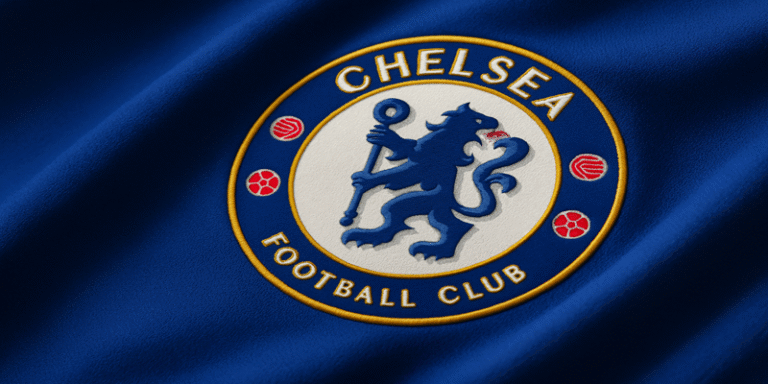Founded in 1905 by Gus Mears, Chelsea Football Club emerged from a vision to convert Stamford Bridge into a football ground after Fulham declined to lease it. To give the stadium a professional tenant, Mears established Chelsea FC, named after the adjacent borough rather than the stadium itself (Glendinning, 2015). The club immediately joined the Football League and began its journey as one of the most recognisable names in English football.
Early Years: Establishing Identity (1905–1955)
Chelsea’s early years were characterised by massive crowds and a grand image, though their success on the pitch was limited. Known initially as “The Pensioners”, a reference to the Chelsea Royal Hospital veterans, the club adopted a more modern lion rampant crest in the 1950s under manager Ted Drake, as part of a rebranding effort to modernise the club (Inglis, 1996).
Chelsea’s first major triumph came in 1955, when they won the First Division title under Drake, marking the club’s breakthrough on the domestic stage (Rollin & Rollin, 2005).
Mid-Century Turmoil and Recovery (1955–1996)
The decades following their first title were tumultuous. The ambitious redevelopment of Stamford Bridge in the 1970s caused severe financial difficulties. Ownership instability compounded the challenges, and the club hovered between the First and Second Divisions (Glanville, 2006).
In 1982, businessman Ken Bates famously purchased Chelsea for £1, later floating the club on the stock exchange. However, financial woes lingered due to the stadium freehold being separated from the club, placing Chelsea in existential danger (Conn, 1997).
The 1990s marked a turning point with the arrival of high-profile foreign players and the appointment of Ruud Gullit as player-manager in 1996. This period brought renewed prestige, including an FA Cup win in 1997, signalling Chelsea’s return to prominence (King, 2002).
The Abramovich Era: Global Power (2003–2022)
The most transformative moment in Chelsea’s history came in 2003, when Russian businessman Roman Abramovich acquired the club. His investment eradicated debts and financed world-class signings and infrastructure (Conn, 2004). This marked the dawn of an era of unprecedented success, with Chelsea quickly becoming a dominant force in both English and European football.
Under José Mourinho, Chelsea secured their first league title in 50 years during the 2004–05 season, followed by another in 2005–06. Mourinho instilled a winning mentality, famously labelling himself “The Special One” and delivering consistent domestic success (Gibson, 2005).
Abramovich’s financial backing also improved youth development, training facilities, and the global profile of the club, leading scholars to cite Chelsea as a prime example of the commercialisation and globalisation of football (Hamil & Walters, 2010).
European Glory and Trophy Haul
Abramovich’s era delivered Chelsea’s most celebrated achievement: their first UEFA Champions League in 2012, achieved under interim manager Roberto Di Matteo. They repeated the feat in 2021, this time under Thomas Tuchel (UEFA, 2021).
Chelsea also became the first club to win all four major UEFA competitions—the Champions League, Europa League, Cup Winners’ Cup, and the Conference League (UEFA, 2025). The club’s European dominance was matched with domestic consistency, collecting six league titles, eight FA Cups, and five League Cups over their history (Premier League, 2024).
BlueCo Ownership and Modern Transition (2022–Present)
In 2022, Chelsea underwent another ownership transformation after Abramovich sold the club due to UK government sanctions. The new consortium, BlueCo, spearheaded by Todd Boehly, inherited a club with global reach but facing the challenge of maintaining success in an evolving football economy (BBC Sport, 2022).
Despite turbulence, Chelsea claimed the UEFA Conference League in 2025, underscoring resilience during a period of transition (The Sun, 2025).
Identity, Culture, and Global Reach
Chelsea’s fan culture has undergone significant shifts. Traditionally rooted in working-class West London, the club has since expanded into a global brand, boasting millions of fans worldwide (Giulianotti & Robertson, 2009). Stamford Bridge, with a capacity of over 40,000, remains at the heart of this identity.
Chelsea’s fielding of an entirely foreign starting XI in 1999 exemplified the club’s internationalisation (King, 2002). Today, Chelsea is among the most digitally followed clubs in the world, reflecting football’s transformation into a globalised cultural product (Boyle & Haynes, 2004).
Legacy and Records
Chelsea’s honours cabinet is among the most decorated in English football. They hold records for pioneering firsts: the first English club to wear shirt numbers (1928), the first to travel by aeroplane to a match (1957), and the first to win the Premier League–FA Cup double in the modern era (2010) (Inglis, 1996; Glanville, 2006).
The club’s sustained trajectory—rising from financial struggles to European supremacy—makes Chelsea emblematic of the evolution of modern football, driven by investment, globalisation, and branding.
Chelsea’s journey from its humble beginnings in 1905 to becoming a global football powerhouse is one of transformation and resilience. The club’s story reflects broader themes in modern football: the tension between tradition and commercialisation, the impact of global capital, and the pursuit of sporting excellence.
From Gus Mears’ vision to Abramovich’s empire and the BlueCo consortium, Chelsea has consistently adapted, reinvented itself, and achieved success. In doing so, it has not only collected trophies but also symbolised the ever-changing cultural, economic, and global dynamics of the sport.
References
BBC Sport (2022) Chelsea: Todd Boehly-led consortium completes £4.25bn takeover. Available at: https://www.bbc.com/sport/football/61585815 (Accessed: 19 August 2025).
Boyle, R. and Haynes, R. (2004) Football in the new media age. London: Routledge.
Conn, D. (1997) The football business: Fair game in the ’90s? Edinburgh: Mainstream.
Conn, D. (2004) ‘Abramovich’s revolution at Chelsea’, The Guardian, 25 August.
Gibson, O. (2005) ‘Mourinho’s special touch turns Chelsea into champions’, The Guardian, 1 May.
Giulianotti, R. and Robertson, R. (2009) Globalization and football. London: Sage.
Glanville, B. (2006) Chelsea FC: The official biography. London: Headline.
Glendinning, B. (2015) The birth of Stamford Bridge and Chelsea FC. London: Carlton.
Hamil, S. and Walters, G. (2010) ‘Financial performance in English professional football: “An inconvenient truth”’, Soccer & Society, 11(4), pp. 354–372.
Inglis, S. (1996) The football grounds of Great Britain. 3rd edn. London: CollinsWillow.
King, A. (2002) The end of the terraces: The transformation of English football. 2nd edn. London: Leicester University Press.
Premier League (2024) Club honours: Chelsea FC. Available at: https://www.premierleague.com (Accessed: 19 August 2025).
Rollin, J. and Rollin, G. (2005) Sky Sports football yearbook 2005–2006. London: Headline.
The Sun (2025) Chelsea complete set of UEFA trophies with Conference League win. Available at: https://www.thesun.co.uk/sport/35161410/chelsea-conference-league-trophy-win (Accessed: 19 August 2025).
UEFA (2021) Chelsea crowned Champions League winners. Available at: https://www.uefa.com (Accessed: 19 August 2025).
UEFA (2025) Chelsea become first club to win all four UEFA trophies. Available at: https://www.uefa.com (Accessed: 19 August 2025).









